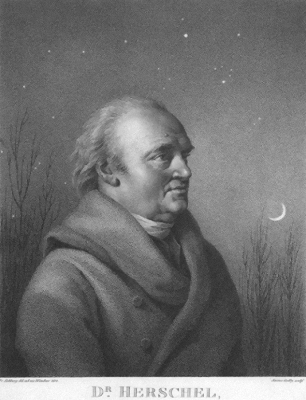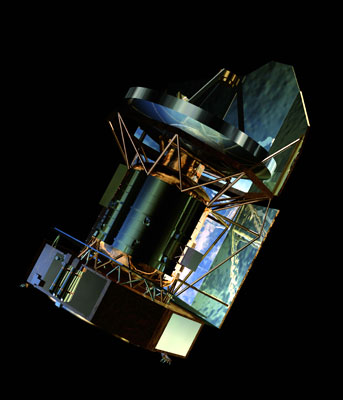
| Sir William Herschel discovered, in addition to the planet Uranus, many new nebulae, clusters of stars and binary stars. He was the first person to correctly describe the form of our Galaxy, the Milky Way. In 1800, the German-born British astronomer and musician described that the differently coloured filters through which he observed the Sun allowed different levels of heat to pass. He performed a simple experiment to study the Credits: Royal Astronomical Observatory |

| Caroline Herschel, sister of Sir William Herschel. Pioneer in her own right in intrared studies. |

Download: |
| Herschel's telescope will collect infrared radiation from distant stars. Image shows telescope, vessel containing liquid helium cryostat (narrow, middle part), and service module at the bottom. Credits: ESA 2002/Medialab |
The Herschels were pioneers of the systematic classification and investigation of the heavens. William Herschel was one of the first 'professional' astronomers, and discovered infrared radiation. His sister Caroline helped him to develop the modern mathematical approach to astronomy.
William, son of a musician, was born in Hanover, Germany, in 1738. He followed in his father's marching footsteps, joining the Hanoverian Guard band to play the oboe. Herschel moved to England to become a teacher in 1755, eventually settling in Bath in 1766.
He became interested in astronomy, and started to build his own telescopes. He developed and refined the reflector design first suggested by Isaac Newton to avoid problems with poor glass optics. Herschel cast and polished his own mirrors, producing ever bigger and better telescopes.
In 1772, he invited Caroline to join him as an assistant in his musical business, and she moved to Bath too. Both enjoyed watching the skies and, in 1781, William discovered the planet Uranus. He named it briefly 'Georgium Sidus' in honour of the British King. The discovery of the new planet inspired Herschel to end his career as a musician and teacher and concentrate on astronomy. King George appointed William his private astronomer, and the Herschels moved to Slough, near Windsor, England.
By 1789, Herschel had built a 12-metre reflector, the largest telescope of its day. Meanwhile Caroline became the first woman to discover a comet, and discovered seven more in the years between 1786 and 1797, and then discovered three nebulae. In 1787 she was granted a salary of £50 by the King to act as her brother's assistant. Caroline worked hard in her own right, and in 1797 she published the 'Index to Flamsteed's Observations of the Fixed Stars' and a list of his mistakes.
After discovering moons around Saturn and Uranus, Herschel turned his attention from the planets to the stars, and drew up a catalogue of double stars that he showed were orbiting pairs. His paper 'On the Construction of the Heavens', published in 1784, modelled the formation of our Galaxy, the Milky Way, and marked the beginnings of Herschel's life-long interest in the cataloguing of the Universe.
In 1800, Herschel described that the different coloured filters through which he observed the Sun allowed different levels of heat to pass. He performed a simple experiment to study the 'heating powers of coloured rays': he split the sunlight with a glass prism into its different constituent rainbow colours and measured the temperature of each colour. He observed an increase in temperature as he moved a thermometer from the violet to the red part of the 'rainbow'.
Out of curiosity, Herschel also measured temperatures in the region just beyond the red colour where no light was visible and, to his surprise, he recorded the highest temperature there. He deduced the presence of invisible 'calorific' rays, now called 'infrared' radiation, and the reason why ESA's planned infrared observatory is named after him. Over the rest of his life, he produced lists of thousands of nebulae and star clusters, and he was the first to distinguish between distant clusters and dusty nebulae.
After William's death in 1822, Caroline returned to Hanover and re-organised his catalogues into one extensive book, for which she was awarded the Gold Medal of the Royal Astronomical Society, and was later elected a member, in 1828. An asteroid was named Lucretia in 1889 in her honour. This was a fitting tribute to someone who had contributed so much yet disliked the praise directed towards her if it detracted from her brother William.
The Herschels' work marked the first time that a new planet had been discovered with a mechanical aid, a telescope. Although the word had not yet been invented, the Herschels were among the first 'scientists', as distinct from natural philosophers. They were concerned with classification and orderings of the Universe, as opposed to discovering why things happen. Their approach to science was symbolic of a new style, following on from the experimental rationalism of Boyle and Newton.



0 comments:
Post a Comment